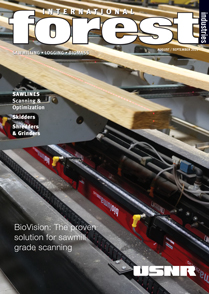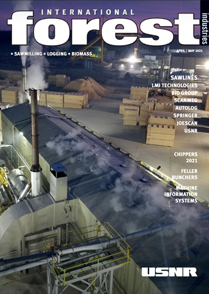EDITOR’S COMMENT ISSUE 83
Timber demand to taper
I ’ve dedicated these column inches over recent times to a couple of major trends that I must admit – as someone leveraged to the forestry sector – I’ve enjoyed watching unfold.
One of those has obviously been the rise in demand for wood products as the COVID-19 pandemic has seen millions upon millions across the world forced to abandon their dreams of overseas holidays – and, for many, just the opportunity to get down to the a restaurant, or even have a drink at the local pub – as government restrictions have clamped down on personal freedoms in a bid to curb the spread.
The alternative for a huge number of people – particularly with local DIY franchises categorised as ‘essential’ retailers – was to plough the money saved into jobs around the house that had long been put off. More so, the inability for estate agents to show homes also meant people stopped buying houses and instead invested in major renovation projects.
The other trend has been the rise of timber as a sustainable but increasingly reliable construction material for structural supports as opposed to its usual use in frames for windows, roofing, stud walls and an outrageous number of subsidiary functions. This has been in conjunction with the need to ‘build back green’; a promise from politicians that has pushed construction and development solutions firmly toward materials considered sustainable and specifically carbon neutral.
COVID has also injected huge supply disruption into usually sound value chains, exaggerating supply-side struggles.
This has seen the much talked about rise in prices – the Wood Resource Quarterly reports that softwood prices under its coverage have risen in 21 of the 22 regions it covers in the past year; the most material rises have by far been in Europe and British Columbia.
While I’m wary I’ve been as bullish as any other on the long-term likelihood of sustained strength in wood pricing, I’m getting the feeling we may be entering an interim period of tapering back – a correction, if you will. Though the fundamentals are sound in the longer term, there is plenty of truth in the old saying that “the best cure for high prices is high prices”.
Speaking in this instance from personal experience, I have been looking at getting a pergola built and the quote has changed twice in the three-month period from the initial quote to the suggested point of execution; to such a degree that I have gone from looking at a hardwood option, to softwood and, now, looking at options that don’t use wood at all – there are great metal structures or material sails if I want to scale back completely.
There are many things that you can’t substitute wood out for – at least not given other pressures around responsible sourcing and carbonsensitive materials – but the demand around the margins feels almost certain to wane as borders open, travelling becomes easier, and therefore the competition for the discretionary dollar becomes more intense.
Also of note is a likely change in tack over in China – a huge wood consumer. The sustainability agenda looks to have been put on the backburner as it enters a winter with potentially serious energy outages that it has told its utilities must be avoided at all costs. This has seen immediate practicalities replace longterm sustainability on the political agenda.
Ultimately, as COP26 gets underway (days away at time of writing), the thrust toward sustainability and the demand for wood will be reinforced, but this is unlikely to convince the millions considering wood-based projects over the next 12 months to swallow current pricing.
Enjoy
Chris Cann




